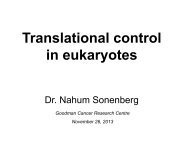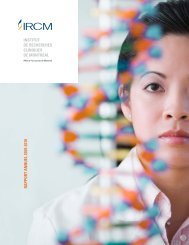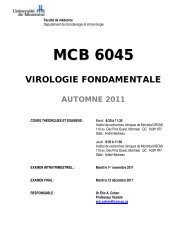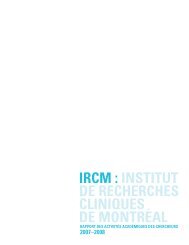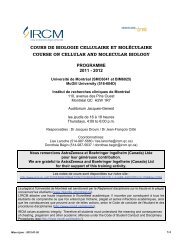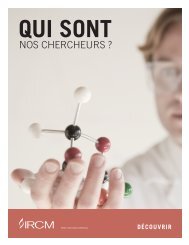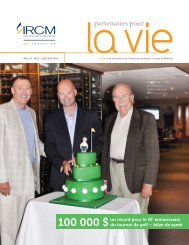Polo - IRCM
Polo - IRCM
Polo - IRCM
- No tags were found...
Create successful ePaper yourself
Turn your PDF publications into a flip-book with our unique Google optimized e-Paper software.
Le cycle de la divisioncellulaire eucaryote
Plan du coursPARTIE I: Théorie sur les centrosomes et les cils1- Découverte du centrosome2- Fonctions des centrosome et des cils3- Biogénèse des centrioles et des cils4- Centrosomes et cils dans les maladies humaines5- Les centrosomes: essentiels? facultatifs? nuisibles?PARTIE II: Présentation de recherche:Régulation du cycle cellulaire et des centrosomes par des kinaseet phosphatases
PARTIE IThéorie sur les centrosomeset les cils
1- Découverte du centrosome
Theodor BoveriDécouvreur du centrosome (1888), qu’il décrit comme“the especial organ of cell division”.
Theodor BoveriDécouvreur du centrosome (1888), qu’il décrit comme“the especial organ of cell division”.
Le centrosomeBettencourt-Dias & Glover, 2007, NRMCB
Structure d’un centrosome de vertébréBrito et al, 2012. Deconstructing thecentriole: structure and number control.Current Opinion in Cell Biology.
Brito et al, 2012. Deconstructing thecentriole: structure and number control.Current Opinion in Cell Biology.
2- Fonctions des centrosomes et des cils
Les centrosomes organisent les microtubules pour la formationd’un fuseau bipolaire en mitose
L’assemblagedes microtubulesKollman et al, 2011.Nat Rev Mol Cell Biol.
Le complexe de la g-Tubuline (gTubulin Ring Comlex; gTuRC)Kollman et al, 2011. Nat Rev Mol Cell Biol.
Nucléation des microtubules aux centrosomes par le gTuRCKollman et al, 2011. Nat Rev Mol Cell Biol.
Les centrosomes sont souvent associés à l’enveloppe nucléaire en interphase.
Les centrosomes sont souvent associés à l’enveloppe nucléaire en interphase.Topology and functions of LINC complexes.Razafsky & Hodzic, 2009, JCB
www.ncbi.nlm.nih.govLe cycle cellulaire chez deux levures
Mitose ouverte, mitose fermée, mitose semi-ferméeHumainsLevuresMouchesChampignonsGüttinger et al, 2009.Nature Reviews Molecular Cell Biology.
LevuresbourgeonnantesVertébrésLim et al. 2009. Regulation ofcentrosome separation inyeast and vertebrates:common threads.Trends in Cell Biology.
Le point de restriction du positionnement du fuseau(Spindle Orientation Checkpoint; SPOC)Caydasi et al, 2010, Cell Div
Les centrioles permettent la formation des centrosomes et des cilsengagedappendagesRaff & Nigg. 2009. Cell
3-Biogénèse des centrioles et des cils
Le cycle de duplication des centriolesCdk2, Plk4Raff & Nigg. 2009. Cell
Le cycle de duplication des centrioles est régulé par la kinase Plk4.Plk4 degradéPlk4 activéSillibourne & Bornens, 2010. Cell Division.
Identification of SAS-6 as a key element of the centriolar cartwheel.(a) Immunolocalization of the SAS-6 protein (also known as Bld12p) to the central hub of the cartwheel in Chlamydomonas reinhardtiiimaged by electron microscopy. Top images show longitudinal sections through wild-type centrioles; note the immunogold-labelling of thecarthwheel by anti-SAS-6 antibodies (right). Bottom; immunogold-labelling of centriole in cross-section, showing that SAS-6 localizes tothe central part of the cartwheel (right). Schematic representation (left) shows cartwheel in red. Scale bars,100 nm. Reproduced withpermission from ref. 35. (b). Structural model of a SAS-6 oligomer (upper panel) and rotary-metal-shadowing electron micrographs of thesame structure (lower right panel; schematic representation of structure is shown on the left). Both images emphasize the importance ofSAS-6 for conferring ninefold rotational symmetry to the centriole. (Reproduced with permission from ref. 38).Nigg & Stearns, 2011. The centrosome cycle: Centriole biogenesis, duplication and inherent asymmetries. Nat Cell Biol.
The centrosome cycle.Nigg, 2007. Trends in Cell Biology.
Le point de restriction de l’assemblage du fuseau(spindle assembly checkpoint; SAC)Musacchio & Salmon, 2007, NRMCBPeters, 2006, NRMCB
Régulation de la cohésion entre chromatides sœurs.Archambault & Glover, 2009, Nat Rev Mol Cell Biol.
Coordination du cycle des centrosomes avec la ségrégation des chromosomesThe dual use of cohesin ensures coordination of the chromosome- and the centrosomecycle. The model proposes that centrioles (shades of grey), in a similar way to sisterchromatids (light blue), are held together by two pools of cohesin (red), that is, aprophase-responsive fraction and one protected by shugoshin 1 (dark blue).Consequently, centriole disengagement and sister-chromatid separation occur in highlysimilar fashions, with separase removing the last of cohesin by proteolytic cleavage ofScc1.
4- Centrosomes et cils dans les maladies humaines
Raff & Nigg. 2009. CellProblèmes de centrosomes et instabilité génomique
Raff & Nigg. 2009. CellProblèmes de centrosomes et maladies
Raff & Nigg. 2009. CellProblèmes de centrioles et maladies
5- Les centrosomes: essentiels? facultatifs? nuisibles?
Fig 4. DSas-4S2214 Mutant Flies AreMorphologically Normal, but Lack Cilia
Deux voies contribuent à la formation du fuseau mitotique ou méiotiquePar les centrosomesPar les chromosomes
femellemâlepupeLe cycle de viede la drosophile(9 jours)embryonlarve 1pré-pupelarve 2larve 3
L’embryon de drosophileet la contribution maternelle13 X S/M
Développement de l’embryon syncytial de la drosophileLes noyaux migrent vers le cortexlors de leurs divisions,poussés par une cage de microtubules.Archambault & Pinson (2010) Fly.
Les microtubules astraux génèrent une poussée qui force les noyaux à migrer vers le cortex.Foe, Odell & Edgar in Textbook The Development of Drosophila melanogaster, Bate & Martinez‐Arias (1993).
Embryon syncytial de drosophileClaudioSunkel
Deux voies contribuent à la formation du fuseau mitotique ou méiotique.Par les centrosomesDans l’embryonde la mouchePar les chromosomes
La méiose femellechez la drosophile se faitdans un syncytium.Arrêt en métaphase IMétaphase IIAnaphase II
Deux voies contribuent à la formation du fuseau mitotique ou méiotique.Par les centrosomesDurant la méiosefemellede la mouchePar les chromosomes
Fertilisation et première mitose chez la drosophileFoe, Odell & Edgar in Textbook The Development of Drosophila melanogaster, Bate & Martinez-Arias (1993).
Références (Partie I)Archambault & Glover, 2009, Nature Reviews Molecular Cell Biology.Archambault & Pinson, 2010. Free centrosomes: Where do they all come from? Fly (Austin).Basto et al, 2006. Flies without centrioles. Cell.Bettencourt-Dias & Glover, 2007. Centrosome biogenesis and function: centrosomics brings new understanding. Nature ReviewsMolecular Cell Biology.Brito et al, 2012. Deconstructing the centriole: structure and number control. Current Opinion in Cell Biology.Caydasi et al, 2010. Monitoring spindle orientation: Spindle position checkpoint in charge. Cell Division.Foe, Odell & Edgar in Textbook The Development of Drosophila melanogaster, Bate & Martinez‐Arias (1993).Güttinger et al, 2009. Orchestrating nuclear envelope disassembly and reassembly during mitosis. Nature Reviews Molecular Cell Biology.Kollman et al, 2011. Microtubule nucleation by γ-tubulin complexes. Nature Reviews Molecular Cell Biology.Lim et al. 2009. Regulation of centrosome separation in yeast and vertebrates: common threads. Trends in Cell Biology.Nigg, 2007. Centrosome duplication: of rules and licenses. Trends in Cell Biology.Nigg & Stearns, 2011. The centrosome cycle: Centriole biogenesis, duplication and inherent asymmetries, Nature Cell Biology.Razafsky & Hodzic, 2009. Bringing KASH under the SUN: the many faces of nucleo-cytoskeletal connections. Journal of Cell Biology.Raff & Nigg, 2009. Centrioles, Centrosomes, and Cilia in Health and Disease. Cell.Sillibourne & Bornens, 2010. <strong>Polo</strong>-like kinase 4: the odd one out of the family. Cell Division.
PARTIE IIPrésentation de recherche:Régulation du cycle cellulaire et descentrosomes par des kinase etphosphatases
InterphaseAnaphasePromotingComplexUbUbUbMitoseCdk inactiveCdkactiveCyclineCyclineEnveloppe nucléaire forméeChromosomes décondensésMicrotubules interphasiques…SubstratsPSubstratsBris de l’enveloppe nucléaireCondensation des chromosomesAssemblage du fuseau mitotique…
InterphaseAnaphasePromotingComplexUbUbUbMitoseCdk inactiveCdkactiveCyclineCyclineEnveloppe nucléaire forméeChromosomes décondensésMicrotubules interphasiques…SubstratsPSubstratsPhosphatase(s) Bris de l’enveloppe nucléaireCondensation des chromosomesAssemblage du fuseau mitotique…
ActivityLe moteur du cycle cellulaireCyclin B-Cdk1APCPhosphatase ?MitoticentryMitoticexittimeInterphase- Interphase microtubules- Relaxed chrososomes- Nuclear envelope present- Other eventsMitosis- Mitotic spindle- Condensed chromosomes- Nuclear envelope breakdown- Other eventsInterphase- Interphase microtubules- Relaxed chromosomes- Nuclear envelope present- Other events
La kinase <strong>Polo</strong> dans le cycle de la division cellulaireProphasePrométaphaseMétaphaseMG2<strong>Polo</strong>AnaphaseRéplication de l’ADN(Phase S)G1Télophase et Cytocinèse
La kinase <strong>Polo</strong>, comme la plupart des régulateurs du cycle cellulaire,est conservé entre les espèces.MétaphaseCellulesde mouche<strong>Polo</strong>-GFPMicrotubulesADNCytocinèseCelluleshumainesGFP-Plk1MicrotubulesADN
Embryon syncytial de drosophileClaudioSunkel
Un crible génétique pour des gènes qui fonctionnent avec polo+xpolo -+xpolo -mutationx+embryons viablesembryons mortsC?A<strong>Polo</strong>B??
Identification deScant/greatwall+xpolo -Scant+Embryons mortsWild typepolo - +/+ ScantScott of the Antarticpolo - +/+ ScantArchambault et al, 2007, PLoS Genetics5 m -Tub, g-Tub, DNA
La mutation Scant affecte le gène de la kinase greatwall.K97M = Scant*57 205 705 829 846Kinase N-termfonction inconnueKinase C-termScant = forme hyperactive de Greatwall in vitroGreatwall (Gwl) collabore avec CyclinB-Cdk1 pour stimuler l’entrée en mitosedans des extraits d’oeufs de xénope.GwlCdk1?Entrée en mitose Gwl <strong>Polo</strong>Quel est le lien fonctionnel entreGwl and <strong>Polo</strong>?
La génétique nous disait que:Greatwall<strong>Polo</strong>Détachements de centrosomes,Mitoses détraquées,Mort
Plusieurs modèles possibles1 Gwl <strong>Polo</strong> 2 Gwl <strong>Polo</strong>3Gwl<strong>Polo</strong>XXX4 Gwl <strong>Polo</strong> 5 Gwl <strong>Polo</strong>…XXYEvent
Phénotypes observés avec différents allèlesde greatwallEmbryonsStructures de l’adulteGwlGwlDéfauts du développementdes ailes, des yeux, etcDéfauts des fuseaux mitotiquesNeuroblastes larvairesOvairesGwlGwlDéfauts de condensationet ségrégation des chromosomesPerte de cohésion entre leschromatides soeurs en méiose femelle
Qu’est-ce que Greatwall fait?On retourne à la génétique!
Des détachements de centrosomes sont déjà observéschez les embryons provenant de femelles polo - /+.g-Tub & lamin B, DNApolo - /+Combinées+ ADNProphasePrométaphaseWTg-Tub& lamin BD-TubWang et al, 2011.
Les centrosomes sont requis pour l’assemblage des fuseaux mitotiqueset pour la migration des noyaux dans le syncytium.→Comment les embryons de mères polo - /+ arrivent-ils à se développer si leurs centrosomesse détachent des noyaux???Réponse: Ils se détachent et se rattachent ensuite!polo - /+, GFP-D-TACC, H2A-RFPWT:T 0240 s 300 s 420 s↓ <strong>Polo</strong>:480 s 540 s 600 s 780 s551 s→Bon fond génétique sensibilisé!Wang et al, 2011.
Un crible génétique identifie twinsen interaction avec polo et gwl.polo 11 /Balancer X Df/Balancerpolo 11 /+, Df/+ X Wild-typeEmbryos hatch?Deficiency Cytoloc. % HatchingDf(2L)ED12527 28C4-28D3Df(2L)ED1315 38B4-38F5Df(3L)ED4483 69A5-69D3Df(3L)ED4486 69C4-69F6Df(3R)ED5330 85A5-85D1Df(3R)ED5474 85F11-86B1polo 11 /+ gwl Scant /+2140531304928165015 genes twinsWang et al, 2011.
Protéine Phosphatase 2A est une enzyme hétérotrimériqueavec plusieurs sous-unités régulatrices alternatives.Sous-unitécatalytique= B55, TwinsSous-unitéstructuraleSous-unitérégulatriceControl of mitotic exit by PP2A regulation of Cdc25C and Cdk1 (Forester et al., 2007)Regulated activity of PP2A–B55δ is crucial for controlling entry into and exit from mitosis inXenopus egg extracts. (Mochida et al., 2009)
<strong>Polo</strong> interagit génétiquement avec Twins et Mtsmais pas avec les autres sous-unités de PP2A.Structurale PP2A-29B/+; polo11/+PP2A-B'/polo11Régulatrices wdb/polo11tws/polo11Catalytique mts/+; polo11/+PP2A-29B/+PP2A-B'/+wdb/+mts/+tws/+polo11/+OrR% Éclosion des embryons0 20 40 60 80 100Des interactions génétiques similaires ont aussi été observées entre gwl Scantet tws ou mts.PP2A-Tws est un interacteur fonctionnel critique de <strong>Polo</strong> et Gwl dans l’embryonsyncytial. Wang et al, 2011.
Une augmentation de l’activité de la kinase Gwl est létale dans les embryonsoù l’activité de Tws est réduite.Surexpression de Gwl dans l’embryonUn excès d’activité de la kinase Gwl relativement à PP2A-Tws est létal.gwl ScantSurexpression Gwl↑Gwl + ↓ PP2A-Tws =Wang et al, 2011.
La surexpression de Gwl combinée avec une réduction duniveau de Tws empêche la complétion de la méiose femelle.La majorité des œufs sont bloqués en méiose I.Quelques embryons initient des mitoses mais échouent rapidementet montrent beaucoup de détachements de centrosomes.Wang et al, 2011.
Une réduction du niveau de Gwl restaure partiellement la viabilitédes embryons de mères mts/+ ; polo - /+.GwlPP2APP2AGwlGwl PP2APeut-être que Gwl agit normalement pour inhiber PP2A-Tws durant la mitose?
Oui, et c’est conservé chez les vertébrés…
Question:GwlComment?PP2A-Tws/B55Cyclin B-Cdk1M Exit
Science, Dec 17, 2010:GwlEndosulfineArpp19PLoS Genetics, Aug 11, 2011:PP2A-Tws/B55Cyclin B-Cdk1M Exit
Modèle actuel:Chez les animaux, Greatwall phosphoryle Endos et Arpp19,qui deviennent des inhibiteurs de PP2A-B55/Tws, pour promouvoirla mitose.Endos, Arpp19PEndos, Arpp19Adaptation libre de:Gharbi-Ayachi, A. et al. Greatwall, un nouveau gardien de la mitose.Med Sci (Paris). 2011 Apr;27(4):352-4.
Le moteur du cycle cellulaireActivitéGwl faible Gwl fort Gwl faibleCyclin B-Cdk1APCPP2A-Tws/B55EntréeenmitoseSortiede lamitosetemps
OK, mais quel est le lien avec <strong>Polo</strong>?
tws P /+ polo 11 +/+ tws Pmts XE-2258 /+; polo 11 /+Combinésavec-Tub,ADNg-Tub& laminWTOregon Rpolo11/+/+mts XE-2258 mts/+ /+twins/+tws P /+Pourcentage des noyaux avecun ou deux centrosome(s) détachésSeries3 Prophase-MétaphaseSeries2 Anaphase-TélophaseKaryocinèse-InterphaseSeries1Des mutations dans twsou mts augmentent lesdétachements de centrosomesdans les mutants de polo.mts XE-2258 /+; polo11/mts/+0 5 10 15 20Wang et al, 2011.
Modèle d’une collaboration entre <strong>Polo</strong> et PP2A-TwsNormal:(Endos)GwlPP2A-Tws?<strong>Polo</strong>anaphasekaryocinèse-interphaseprophase(pro)métaphaseCohésion centrosomes-noyaux↓ PP2A-Tws:↓ <strong>Polo</strong>:↓ <strong>Polo</strong>, ↓ PP2A-Tws:Wang et al, 2011.
Références (Partie II)Archambault et al, 2007. Mutations in Drosophila Greatwall/Scant reveal its roles in mitosis and meiosis and interdependence with <strong>Polo</strong>kinase. PLoS Genetics.Boke & Hagan, 2011. <strong>Polo</strong>, greatwall, and protein phosphatase PP2A Jostle for pole position. PLoS Genetics.Gharbi-Ayachi et al, 2011. Greatwall, un nouveau gardien de la mitose. Médecine Science.Gharbi-Ayachi et al, 2010. The substrate of Greatwall kinase, Arpp19, controls mitosis by inhibiting protein phosphatase 2A. Science.Haccard & Jessus, 2011. Greatwall kinase, ARPP-19 and protein phosphatase 2A: shifting the mitosis paradigm.Results & Problems in Cell Differenciation.Mochida et al, 2010. Greatwall phosphorylates an inhibitor of protein phosphatase 2A that is essential for mitosis. Science.Rangone et al, 2011. Suppression of scant identifies Endos as a substrate of greatwall kinase and a negative regulator of protein phosphatase2A in mitosis. PLoS Genetics.Wang et al, 2011. PP2A-twins is antagonized by greatwall and collaborates with polo for cell cycle progression and centrosome attachment tonuclei in drosophila embryos. PLoS Genetics.



